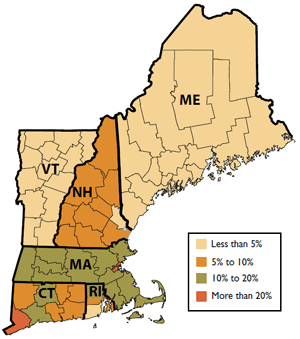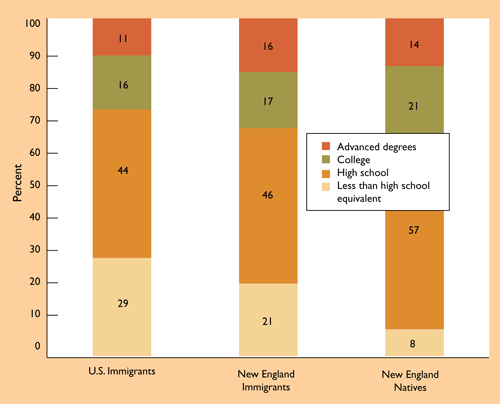The Role of Immigrants in the New England Economy 
Immigrants play an important role in the U.S. economy. Nationally, almost one in six workers is foreign born, and immigrants account for more than 40 percent of labor force growth during the last two decades. New England differs slightly-immigrants comprise a smaller share of the labor force yet account for a greater share of labor force growth than nationally.
The region has the advantage of a better- educated and higher-earning population than national averages. However, its numbers are growing at less than half the national rate, and its average age is rising more quickly. In recent years, net domestic migration has been negative, and the outmigration of well-educated young residents has been high. Shortages of workers, particularly of highly educated engineers and scientists-and certain occupations requiring midlevel skills- could threaten New England's continued prosperity. Immigrants are a vital source of skilled workers for the region.
Economic disparities are another challenge. In recent years, New England has experienced rapid increases in income inequality. [1] The poverty rate is lower than nationally, but poverty is relatively high in several former manufacturing centers and rural areas. Economic growth and job creation have been strongest in cities with sizable health-care and education sectors, and immigrants are concentrated in those same cities. For more economically depressed areas, attracting well-educated immigrants may be a way to spur economic development.
Characteristics
New England states vary greatly with regard to the volume of immigration. In 2009, three New England states had a foreignborn share of population that was slightly higher than the 12.5 percent national average. Those states were Connecticut (13.1 percent), Massachusetts (14.3 percent), and Rhode Island (12.7 percent). The other three states-Maine (3.3 percent), New Hampshire (5.2 percent), and Vermont (3.3 percent)-had considerably smaller proportions of their populations that were foreign born. Within states there was also variation. The highest concentrations were in Suffolk County (home to Boston) and Fairfield County (home to Bridgeport and Stamford). [2] (See "Foreign-Born Population." )
Immigrants are more likely to be employed than U.S. natives, both in New England and across the country. That is partially due to the fact that so many immigrants are in the prime working ages, 25 to 54. Additionally, many come specifically to work, and recent arrivals have little to no access to government benefit programs.
The home countries of New England's immigrants differ from those of immigrants nationwide, where Mexico is the main country of origin, accounting for almost one-third of all immigrants. In New England, less than 3 percent are from Mexico. Canada, the West Indies, South America, and Africa are more common areas of origin in New England than in the rest of the country. Portugal is perhaps the most overrepresented country of origin in New England, accounting for more than 5 percent of immigrants, versus less than 0.3 percent of all immigrants in the United States.
Among adults, immigrants living in New England tend to be better educated than those living elsewhere in the country, being slightly more likely to have completed high school than the average U.S. immigrant. The bigger difference is in advanced degrees. (See "Education Higher Among New England Immigrants." ) The region's universities have played an important role not only in more natives having an advanced degree than the national norm, but also in the degree attainment of the foreign born.
Immigrants and Economic Growth
One way that immigrants contribute to economic growth is by adding to the labor force. That increases total output and gross domestic product (GDP). Most of the gain accrues to immigrant workers in the form of their earnings, but natives gain as well. Business owners benefit from lower labor costs and a larger customer base. Natives benefit from lower prices for goods and services produced by immigrants. Although some natives compete with immigrants for jobs, others benefit from working alongside immigrants. They may even have a job because of them. Natives often have different skills and work in different jobs. In economic jargon, immigrants are complements or imperfect substitutes for natives, not perfect substitutes.
Foreign-Born Population
Shares highest in urban areas of Massachusetts and Connecticut

New England has been fortunate in an immigrant population that is relatively high skilled. Recent research provides convincing empirical evidence that high-skilled immigrants play an important role in innovation and research and development. Highly educated immigrants receive patents at more than twice the rate of highly educated natives. The difference has been linked to immigrants' overrepresentation in STEM fields (science, technology, engineering, and mathematics) and the growing number of immigrants entering on employment-based and student visas.[3] There is also evidence that immigration boosts natives' patent activity.
Highly educated immigrants' entrepreneurial activities have been instrumental in the growth of the U.S. high-tech sector. In New England, more than one-quarter of biotechnology firms have an immigrant founder. In one year (2006), those firms employed more than 4,000 workers.[4]
Innovation and entrepreneurship predominately involve highly educated immigrants, but less educated immigrants contribute to the economy as well. They may pick crops, build houses, or provide household services, among other activities. In New England, less educated immigrants are particularly important to the leisure and hospitality industry.
Population Loss
For several decades, New England and Midwest states have lost people, businesses, and political representation. Nevertheless, some cities have thrived, bucking the regions' overall trends, and highly educated immigrants (together with educated natives) have played important roles. The immigrants are concentrated in areas that have relatively strong economies. A virtuous circle is evident: robust economic growth attracts skilled immigrants, and skilled immigrants boost economic growth.
Education Higher Among New England Immigrants

Source: American Community Survey 2007-2009. Individuals ages 25 and above.
But what about areas that are struggling economically, like parts of rural New England and postindustrial midsize cities? These areas often have small shares of immigrants, and those immigrants they do attract are less likely to be highly educated. To attract skilled immigrants, special initiatives may be needed, such as recruiting foreign students and encouraging them to stay when they graduate from local colleges or universities. In order to attract immigrant entrepreneurs (native entrepreneurs, too), local governments can use tax breaks and other incentives that reduce the cost of doing business. Federal immigration laws can be used to recruit immigrant investors. By creating a "Regional Center," authorities can devise communityinvestment projects and attract immigrant investors under a special provision of the immigrant- investor visa program.[5]
U.S. immigration policy is generally not designed to promote economic development. The government runs out of H-1B visas for skilled temporary workers in most years because quotas are insufficient. And the immigrant-investor program, though well-intentioned, is costly and difficult to administer. Other nations have a better track record of using immigration for regional economic development. In Canada, for example, the provincial nomination program allows provinces to nominate individuals for an immigrant visa. Provinces can determine the admissions criteria. Less populated provinces are willing to accept family-based immigrants. British Columbia, Ontario, and Quebec, however, favor skilled workers, entrepreneurs, and students.
Pia M. Orrenius is a research officer and senior economist at the Federal Reserve Bank of Dallas. Madeline Zavodny is a professor of economics at Agnes Scott College. The opinions expressed are those of the authors and do not necessarily reflect those of the Federal Reserve Bank of Dallas or the Federal Reserve System.
Endnotes
[1] Russ Gittell and Jason Rudokas, "New England Has the Highest Increase in Income Disparity in the Nation" (Carsey Institute New England Issue Brief no. 4, spring 2007), http://www.carseyinstitute. unh.edu/publications/IB_incomeinequality_07. pdf.
[2] Data from 2007-2009 American Community Survey are available for every county in Connecticut, two counties each in Maine and Massachusetts, one in New Hampshire, three in Rhode Island, none in Vermont. The map shows data for the balance of the state if county-level data are unavailable.
[3] See Jennifer Hunt and Marjolaine Gauthier-Loiselle, "How Much Does Immigration Boost Innovation?" American Economic Journal: Macroeconomics 2, no. 2 (2010): 31-56; William R. Kerr and William F. Lincoln, "The Supply Side of Innovation: H-1B Visa Reforms and U.S. Ethnic Invention," Journal of Labor Economics 28, no. 3 (2010): 473-508; Jennifer Hunt, "Which Immigrants Are Most Innovative and Entrepreneurial?" Journal of Labor Economics 29, no. 3 (2011): 417-457; and Gnanaraj Chellaraj, Keith E. Maskus, and Aaditya Mattoo, "The Contribution of International Graduate Students to U.S. Innovation," Review of International Economics 16, no. 3 (2008): 444-462.
[4] Daniel J. Monti, Laurel Smith-Doerr, and James McQuaid, "Immigrant Entrepreneurs in the Massachusetts Biotechnology Industry" (Malden, Massachusetts: Immigrant Learning Center, 2007), http://www.ilctr.org/wp-content/uploads/2009/09/ immigrants_in_biotechnology.pdf.
[5] Foreign entrepreneurs who invest a minimum of $500,000 in "targeted employment areas" (for example, "high-unemployment or rural areas" ) receive provisional visas that are later converted to permanent resident visas (green cards) under the "EB-5" admission class. There is a requirement that the commercial venture create 10 jobs, but investors can pool their money and use the same employees to reach the required 10 new full-time positions.
Articles may be reprinted if Communities & Banking and the author are credited and the following disclaimer is used: "The views expressed are not necessarily those of the Federal Reserve Bank of Boston or the Federal Reserve System. Information about organizations and upcoming events is strictly informational and not an endorsement."

 About the Authors
About the Authors
Pia M. Orrenius, Agnes Scott College
Madeline Zavodny, Agnes Scott College



